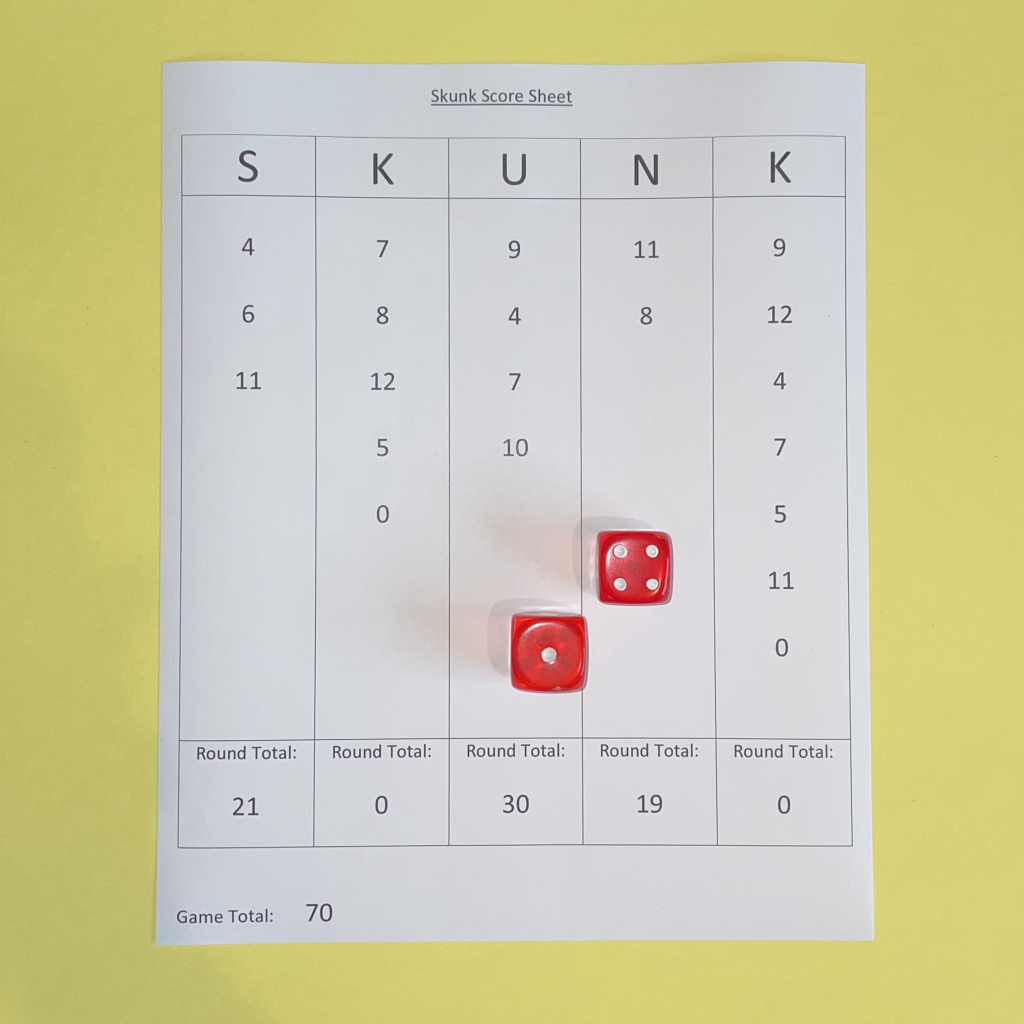Skunk
Junior (Age 9 – 12)
Curriculum Goal
Junior: Data Management
- Describe the likelihood that events will happen, and use that information to make predictions.
Context
- Skunk is played as a whole-group activity.
- Students should have prior experience with theoretical versus experimental probability of events.
Materials
In-person version
- Two dice
- Skunk score sheet for each student (Appendix A)
- Pencils
Online version
- Two virtual dice
- Skunk score sheet
- Video conference capabilities
Lesson
- Each player begins with a Skunk score sheet. The columns on the score sheet are for recording the sum of the dice rolled in each round of the game. There will be five rounds, one for each letter in the word “skunk.”
- To begin round one, all the players will stand up. The teacher will roll two dice and players will add both numbers to determine the first sum.
- Have students indicate their choice by raising or lowering their virtual hand (online version).
- If a one is rolled on either or both dice, the total is zero and the round is over. If a one is not rolled, the sum of the dice will be written down in the first row of the first column (S).
- Prior to the next roll, students must decide whether to:
- Stay Standing: Add the next sum of the dice to their existing total for round one. However, if the next total is zero (either of the dice rolled are a one), the player will lose all the totals for the round and end up with a score of zero for round one.
- Sit down: Lock in the points earned so far and wait for the next round. Players will keep the totals they have recorded so far. The score for this round is the sum of those totals. Players cannot claim any more totals or stand up again in this round.
- When students have made their choice, the teacher will either roll both dice or move on to the next round (if nobody has elected to stay standing).
- Repeat the process of letting students make their choice and then roll the dice until a one appears. After a one has been rolled on either dice, the current round finishes, and the next round (K) begins. Any player who remained standing will lose all their totals and have a score of zero for the round. Students who opted to sit down prior to the dice rolling a one will record their cumulative total for the first round.
- To begin the second round (K), all students will stand up and repeat the steps above.
- After five rounds (SKUNK) have been played, students will calculate their final score. The final score consists of the sum of the five totals from each of the rounds.
- The player with the greatest sum wins the game!

Look Fors
- Can students explain their reasoning for staying standing or sitting down?
- Are students using probability vocabulary (i.e., likely, unlikely, chance)?
- What strategies do students use to make decisions during the game (e.g., do students calculate the probability of rolling a one?)
Extension
- On the dice recording sheet (Appendix B), the teacher can record the dice combinations rolled and their frequency. This can be referenced in discussions about probability (e.g., equiprobability, previous events affect future events).
- Have students calculate how many possible combinations there are when two dice are rolled.
- Have students calculate which sum of dice is most likely to be rolled.
- Record the probability of various dice combinations on a probability line.
- Play the game using three dice. How does this change the likelihood of rolling one on the dice?
Lesson plan by Chen-ling. Adapted by The Robertson Program.
Share this lesson
Share on facebook
Share on twitter
Share on email
